Combined Treatment (Alkali + Thermal) of Calotropis procera Fiber for Removal of Petroleum Hydrocarbons in Cases of Oil Spill
Abstract
1. Introduction
2. Materials and Methods
2.1. Material
2.2. Combined Treatment of Calotropis Procera
2.3. Determination of the Sorption Capacity
2.4. Design of Experiments
2.5. Recycle
2.6. Desorption
2.7. Characterizations
3. Results and Discussion
3.1. Combined Treatment (Alkali + Thermal)
3.2. Design of Experiments
3.3. Effect of Variables on CPNaOHT Sorption Capacity
3.4. Recycle Desorption
3.5. Short Time Sorption Tests
3.6. Characterizations
4. Conclusions
Supplementary Materials
Author Contributions
Funding
Institutional Review Board Statement
Informed Consent Statement
Data Availability Statement
Acknowledgments
Conflicts of Interest
References
- Wahi, R.; Chuah, L.A.; Choong, T.S.Y.; Ngaini, Z.; Nourouzi, M.M. Oil removal from aqueous state by natural fibrous sorbent: An overview. Sep. Purif. Technol. 2013, 113, 51–63. [Google Scholar] [CrossRef]
- Paul, J.H.; Hollander, D.; Coble, V.; Daly, K.L.; Murasko, S.; English, D.; Basso, J.; Delaney, J.; McDaniel, L.; Kovach, C.W. Toxicity and mutagenicity of gulf of Mexico waters during and after the deepwater horizon oil spill, Environ. Sci. Technol. 2013, 47, 9651–9659. [Google Scholar] [CrossRef] [PubMed]
- Instituto Brasileiro do Meio Ambiente e dos Recursos Naturais Renováveis. Localidades Afetadas. 2019. Available online: http://www.ibama.gov.br/phocadownload/emergenciasambientais/2019/manchasdeoleo/2019-11-24_LOCALIDADES_AFETADAS.pdf (accessed on 25 January 2021).
- Zacharias, D.C.; Gama, C.M.; Fornaro, A. Mysterious oil spill on Brazilian coast: Analysis and estimates. Mar. Pollut. Bull. 2021, 165, 112125. [Google Scholar] [CrossRef]
- Hubbe, M.A.; Rojas, O.; Fingas, M.; Gupta, B.S. Cellulosic Substrates for Removal of Pollutants from Aqueous Systems: A Review. 3. Spilled Oil and Emulsified Organic Liquids. Bioresource 2013, 8, 3038–3097. [Google Scholar] [CrossRef]
- Cojocaru, C.; Macoveanu, M.; Cretescu, I. Peat-based sorbents for the removal of oil spills from water surface: Application of artificial neural network modeling. Colloids Surf. A Physicochem. Eng. Asp. 2011, 384, 675–684. [Google Scholar] [CrossRef]
- Li, H.; Li, Y.; Yang, W.; Cheng, L.; Tan, J. Needleless melt-electrospinning of biodegradable poly(lactic acid) ultrafine fibers for the removal of oil from water. Polymers 2017, 9, 3. [Google Scholar] [CrossRef] [PubMed]
- Pintor, A.M.A.; Vilar, V.J.P.; Botelho, C.M.S.; Boaventura, R.A.R. Oil and grease removal from wastewaters: Sorption treatment as an alternative to state-of-the-art technologies. A critical review. Chem. Eng. J. 2016, 297, 229–255. [Google Scholar] [CrossRef]
- Wang, Z.; Barford, J.P.; Hui, C.W.; McKay, G. Kinetic and equilibrium studies of hydrophilic and hydrophobic rice husk cellulosic fibers used as oil spill sorbents. Chem. Eng. J. 2015, 281, 961–969. [Google Scholar] [CrossRef]
- Anjos, R.B.; Anjos, A.S.D.; de Juviniano, H.B.M.; de Dantas, T.N.C.; da Silva, D.R. Study of mandacaru (Cereus jamacaru dc), in natura and modified by microemulsion, as a biosorbent for diesel oil. Acta Sci.—Technol. 2020, 43, e49874. [Google Scholar] [CrossRef]
- Annunciado, T.R.; Sydenstricker, T.H.D.; Amico, S.C. Experimental investigation of various vegetable fibers as sorbent materials for oil spills. Mar. Pollut. Bull. 2005, 50, 1340–1346. [Google Scholar] [CrossRef]
- Deschamps, G.; Caruel, H.; Borredon, M.-E.; Bonnin, C.; Vignoles, C. Oil Removal from Water by Selective Sorption on Hydrophobic Cotton Fibers. 1. Study of Sorption Properties and Comparison with Other Cotton Fiber-Based Sorbents. Environ. Sci. Technol. 2003, 37, 1013–1015. [Google Scholar] [CrossRef]
- Xu, Y.; Su, Q.; Shen, H.; Xu, G. Physicochemical and sorption characteristics of poplar seedfiber as a natural oil sorbent. Text. Res. J. 2019, 89, 4186–4194. [Google Scholar] [CrossRef]
- Hilário, L.S.; Anjos, R.B.; Juviniano, H.B.M.; Silva, D.R. Evaluation of thermally treated Calotropis Procera fiber for the removal of petróleo on the water surface. Materials 2019, 12, 3894. [Google Scholar] [CrossRef]
- Anjos, R.B.; Hilário, L.S.; de Moraes Juviniano, H.B.; da Silva, D.R. Petróleo removal using Calotropis procera. BioResources 2020, 15, 5246–5263. [Google Scholar] [CrossRef]
- Thilagavathi, G.; Praba karan, C.; Das, D. Oil sorption and retention capacities of thermally-bonded hybrid nonwovens prepared from cotton, kapok, milkweed and polypropylene fibers. J. Environ. Manag. 2018, 219, 340–349. [Google Scholar] [CrossRef]
- Fabricante, J.R.; De Oliveira, M.N.A.; Filho, J.A.D.S. Aspectos da ecologia de Calotropis procera (Apocynaceae) em uma área de Caatinga alterada pelas obras do Projeto de Integração do Rio São Francisco em Mauriti, CE. Rodriguésia 2013, 64, 647–654. [Google Scholar] [CrossRef][Green Version]
- Andrade, M.V.M.; Silva, D.S.; Andrade, A.P.; Medeiros, A.N.; Pinto, M.S.C. Fenologia da calotropis procera ait r. br., em funçãodo sistema e da densidade de plantio. Archivos de Zootecnia 2005, 54, 631–634. Available online: https://www.redalyc.org/articulo.oa?id=49520805 (accessed on 17 February 2021).
- Kaur, A.; Batish, D.R.; Kaur, S.; Chauhan, B.S. An Overview of the Characteristics and Potential of Calotropis procera From Botanical, Ecological, and Economic Perspectives. Front. Plant Sci. 2021, 12, 1188. [Google Scholar] [CrossRef]
- Song, K.; Zhu, X.; Zhu, W.; Li, X. Preparation and characterization of cellulose nanocrystal extracted from Calotropis procera biomass. Bioresour. Bioprocess. 2019, 6, 45. [Google Scholar] [CrossRef]
- Kissmann, K.G.; Groth, D. Plantas Infestantes e Nocivas; BASF Brasileira S.A.: São Paulo, Brazil, 1992; 798p. [Google Scholar]
- Husseien, M.; Amer, A.A.; El-Maghraby, A.; Hamedallah, N. A comprehensive characterization of corn stalk and study of carbonized corn stalk in dye and gas oil sorption. J. Anal. Appl. Pyrolysis 2009, 86, 360–363. [Google Scholar] [CrossRef]
- Barros Neto, B.; Scarminio, I.S.; Bruns, R.E. Como Fazer Experimentos, 4th ed.; Editora Bookman: São Paulo, Brazil, 2010. [Google Scholar]
- Wei, Q.F.; Mather, R.R.; Fotheringham, A.F.; Yang, R.D. Evaluation of nonwoven polypropylene oil sorbents in marine oil-spill recovery. Mar. Pollut. Bull. 2003, 46, 780–783. [Google Scholar] [CrossRef]
- Bazargan, A.; Tan, J.; Hui, C.W.; McKay, G. Utilization of rice husks for the production of oil sorbent materials. Cellulose 2014, 21, 1679–1688. [Google Scholar] [CrossRef]
- Ribeiro, T.H.; Rubio, J.; Smith, R.W. A Dried Hydrophobic Aquaphyte as an Oil Filter for Oil/Water Emulsions. Spill Sci. Technol. Bull. 2003, 8, 483–489. [Google Scholar] [CrossRef]
- Teas, C.; Kalligeros, S.; Zanikos, F.; Stournas, S.; Lois, E.; Anastopoulos, G. Investigation of the effectiveness of absorbent materials in oil spills clean up. Desalination 2001, 140, 259–264. [Google Scholar] [CrossRef]
- Anjos, R.B.; Silva, W.P.N.; Silva, A.A.D.; da Barros, S.R.S.; de Carvalho Filho, E.V. Use of statistical modeling for BTEX prediction in cases of crude oil spill in seawater. Environ. Technol. 2021. [Google Scholar] [CrossRef]
- Conselho Nacional Do Meio Ambiente—Conama. Resolução n° 357, Dispõe Sobre a Classificação Dos Corpos de Água e Diretrizes Ambientais Para o Seu Enquadramento, Bem Como Estabelece as Condições e Padrões de Lançamento de Efluentes, e dá Outras Providências de 17 de Março de 2005. Brasília. 2005. Available online: http://www.mma.gov.br/port/conama/res/res05/res35705.pdf (accessed on 17 July 2021).
- Benini, K.C.C.C.; Brocks, T.; Montoro, S.R.; Cioffi, M.O.H.; Voorwald, J.C.H. Effect of fiber chemical treatment of nonwoven coconut fiber/epoxy composites adhesion obtained by RTM process. Polym. Compos. 2017, 38, 2518–2527. [Google Scholar] [CrossRef]
- Yang, H.; Yan, R.; Chen, H.; Lee, D.H.; Zheng, C. Characteristics of hemicellulose, cellulose and lignin pyrolysis. Fuel 2007, 86, 1781–1788. [Google Scholar] [CrossRef]
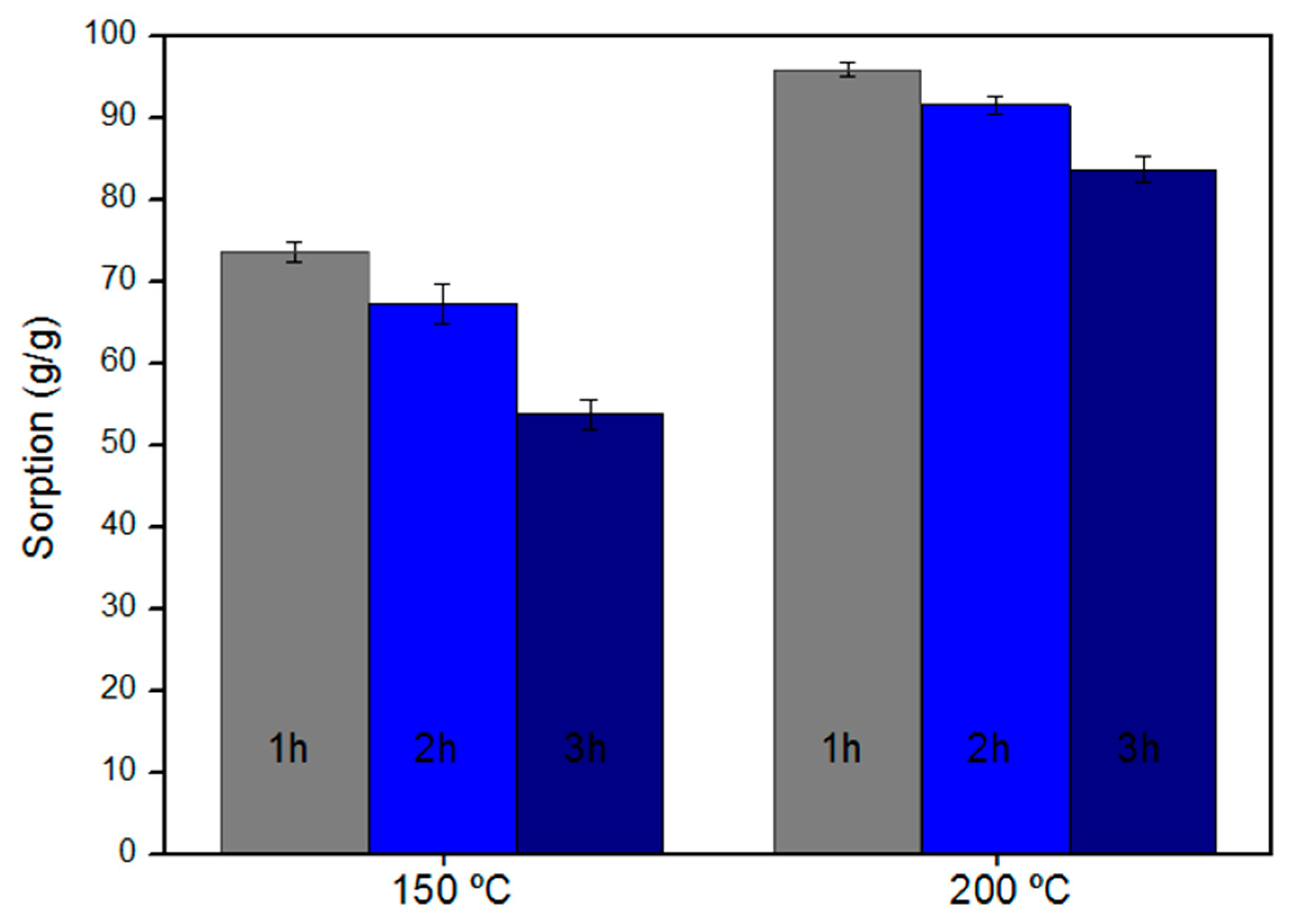
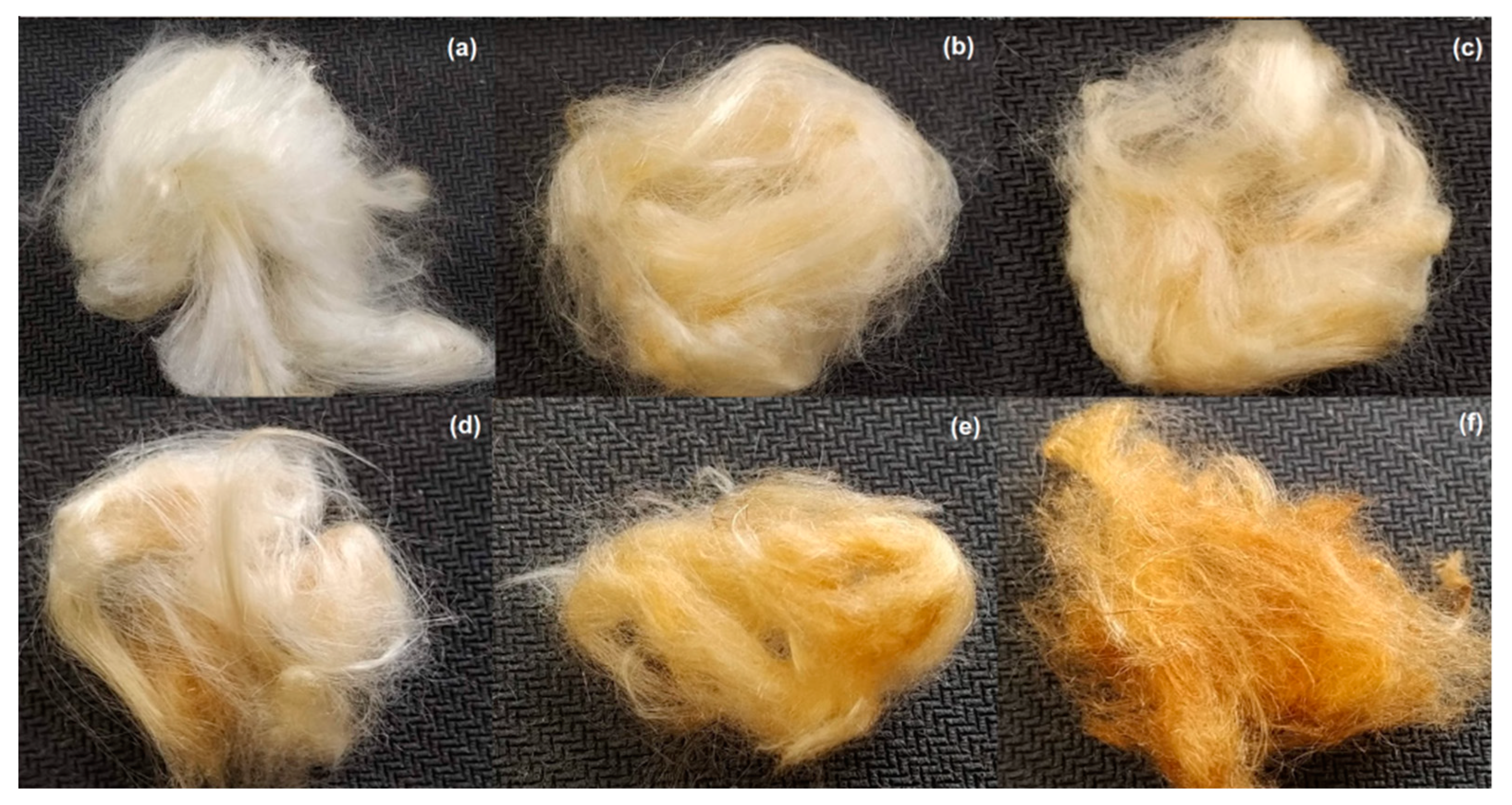
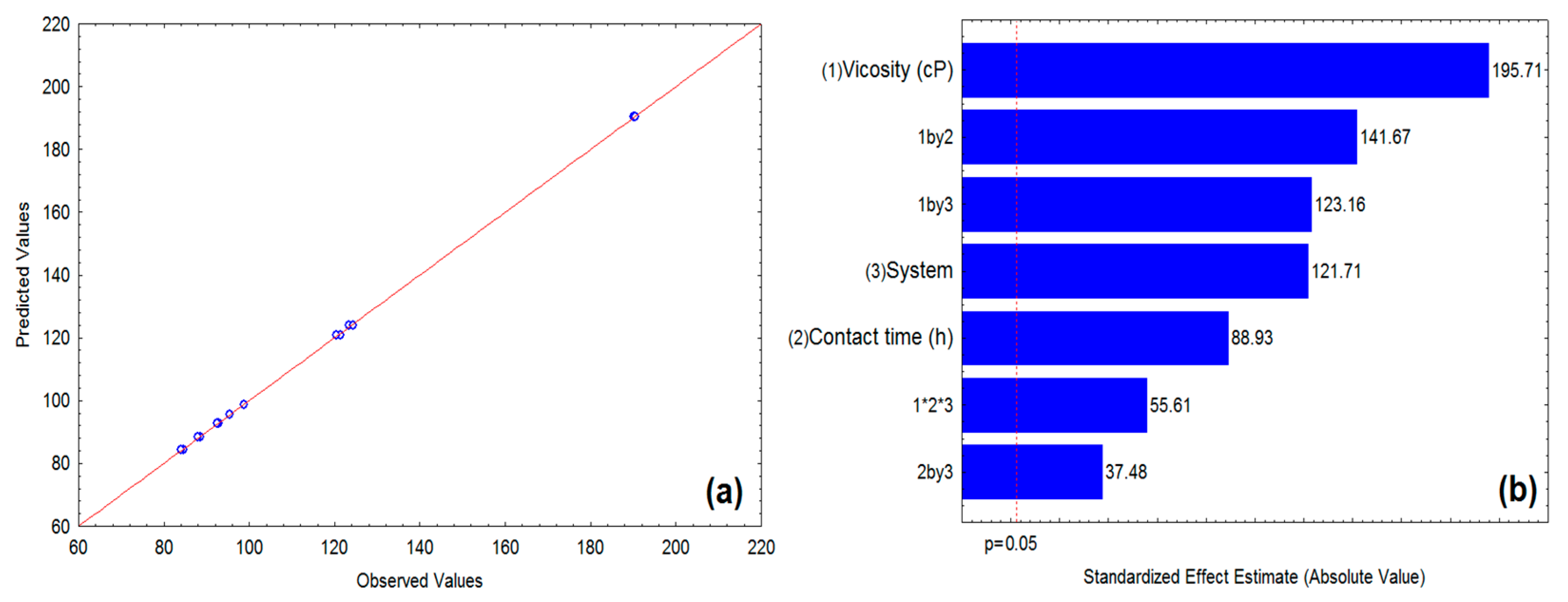

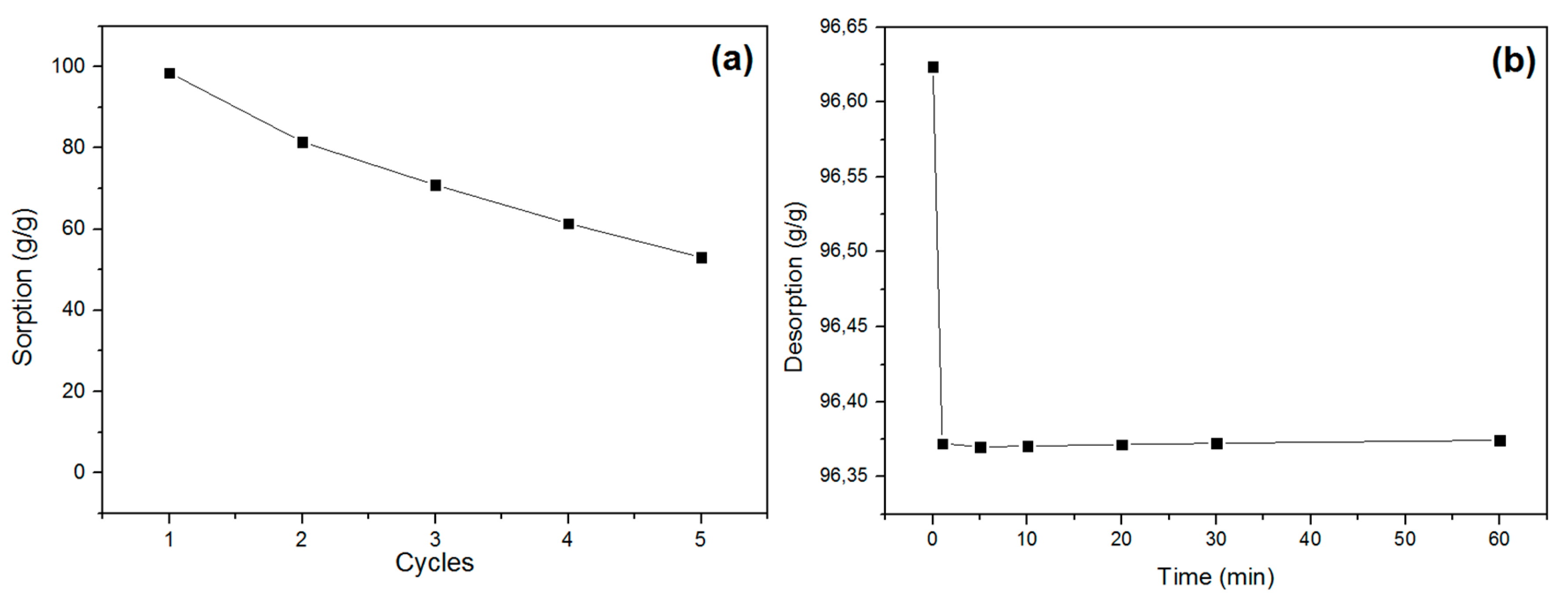
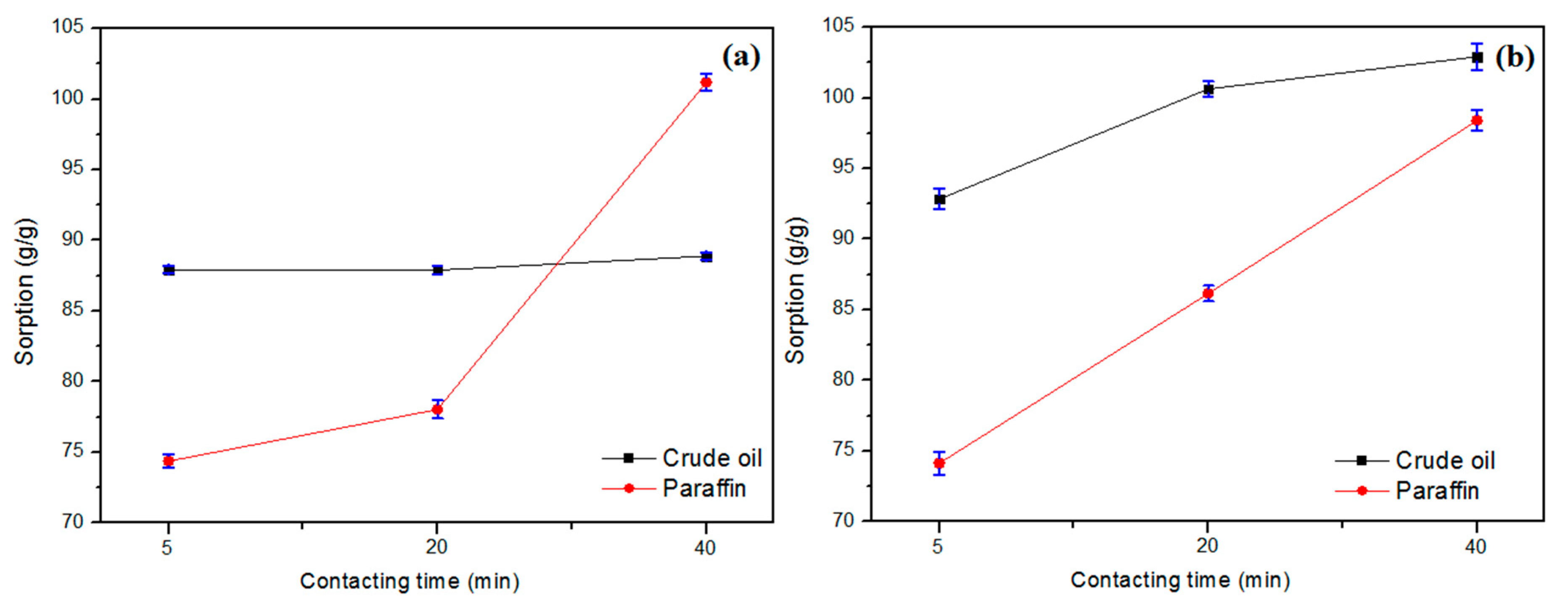
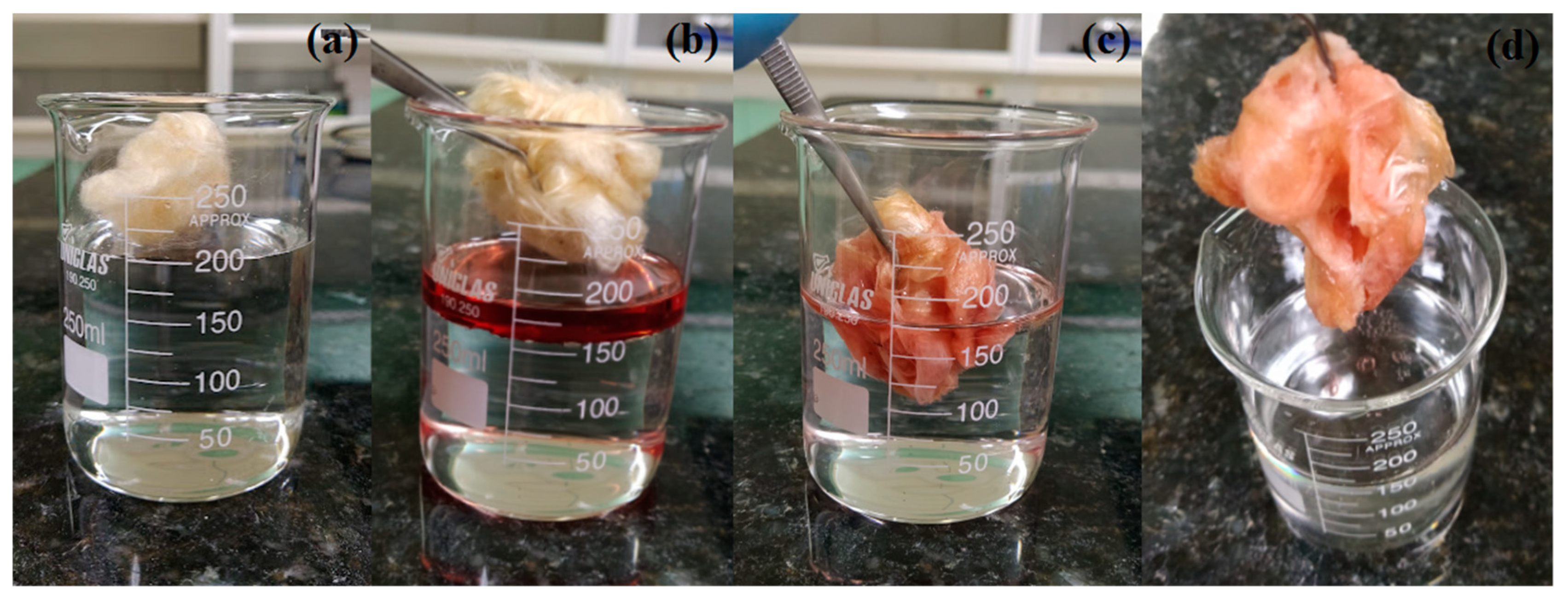
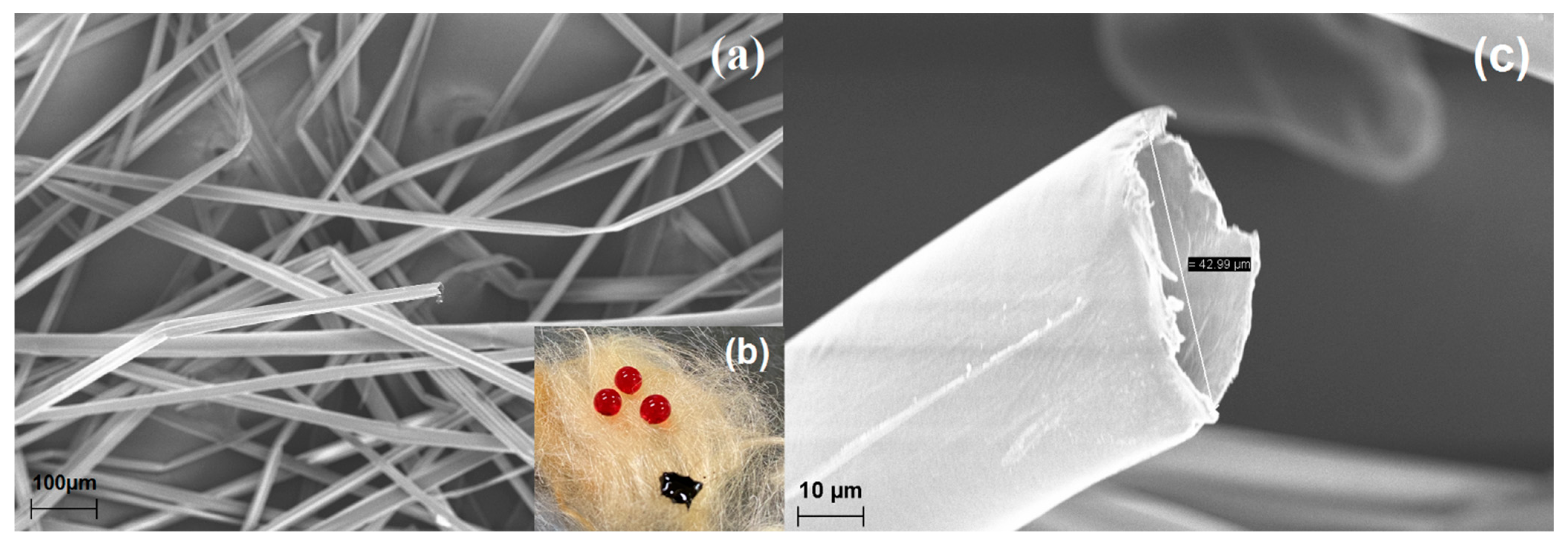


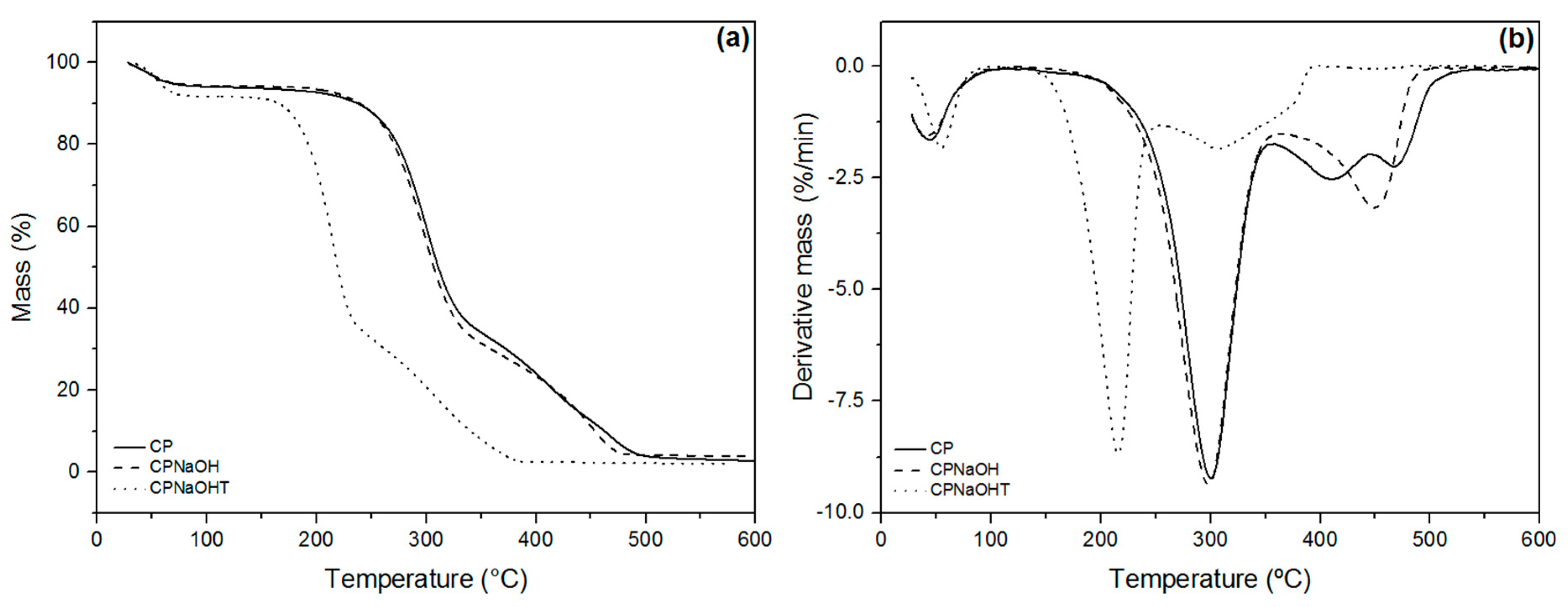
| Factor | Symbol | Level | |
|---|---|---|---|
| −1 | 1 | ||
| Viscosity (cP) | X1 | 2.25 | 73.64 |
| Contact time (h) | X2 | 1 | 24 |
| System | X3 | O | O/W |
| X1 | X2 | X3 | Experimental (g/g) | Calculated (g/g) |
|---|---|---|---|---|
| −1 | −1 | −1 | 95.45 | 95.44 |
| −1 | −1 | −1 | 95.42 | |
| 1 | −1 | −1 | 92.88 | 92.66 |
| 1 | −1 | −1 | 92.44 | |
| −1 | 1 | −1 | 88.61 | 88.32 |
| −1 | 1 | −1 | 88.04 | |
| 1 | 1 | −1 | 121.40 | 120.91 |
| 1 | 1 | −1 | 120.41 | |
| −1 | −1 | 1 | 98.87 | 98.86 |
| −1 | −1 | 1 | 98.85 | |
| 1 | −1 | 1 | 123.36 | 123.84 |
| 1 | −1 | 1 | 124.31 | |
| −1 | 1 | 1 | 84.51 | 84.31 |
| −1 | 1 | 1 | 84.10 | |
| 1 | 1 | 1 | 190.14 | 190.32 |
| 1 | 1 | 1 | 190.50 |
| Source | Sum of Squares | DF1 | Mean Squares | F | p |
|---|---|---|---|---|---|
| (1) Viscosity (cP) | 6463.76 | 1 | 6463.758 | 38,302.33 | 5.20 × 10−16 |
| (2) Contact time (h) | 1334.62 | 1 | 1334.624 | 7908.59 | 2.85 × 10−13 |
| (3) System | 2499.75 | 1 | 2499.750 | 14,812.78 | 2.32 × 10−14 |
| 1 by 2 | 3386.95 | 1 | 3386.949 | 20,070.07 | 6.89 × 10−15 |
| 1 by 3 | 2559.60 | 1 | 2559.601 | 15,167.44 | 2.11 × 10−14 |
| 2 by 3 | 237.08 | 1 | 237.083 | 1404.88 | 2.82 × 10−10 |
| 1*2*3 | 521.78 | 1 | 521.780 | 3091.91 | 1.21 × 10−11 |
| Regression | 17,003.54 | 7 | 2429.078 | Significant and predictive | |
| Residuals | 1.35 | 8 | 0.168756 | ||
| Total | 17,004.89 | 15 | |||
| R-sqr = 0.99992 | R-adj = 0.99985 | Fcalc = 14394 | Fcalc/Ftab = 4112.572 | ||
Publisher’s Note: MDPI stays neutral with regard to jurisdictional claims in published maps and institutional affiliations. |
© 2021 by the authors. Licensee MDPI, Basel, Switzerland. This article is an open access article distributed under the terms and conditions of the Creative Commons Attribution (CC BY) license (https://creativecommons.org/licenses/by/4.0/).
Share and Cite
dos Anjos, R.B.; Hilário, L.S.; dos Anjos, A.S.D.; de Araújo Costa, E.C.T.; Frota, T.M.P.; Gondim, A.D.; da Silva, D.R. Combined Treatment (Alkali + Thermal) of Calotropis procera Fiber for Removal of Petroleum Hydrocarbons in Cases of Oil Spill. Polymers 2021, 13, 3285. https://doi.org/10.3390/polym13193285
dos Anjos RB, Hilário LS, dos Anjos ASD, de Araújo Costa ECT, Frota TMP, Gondim AD, da Silva DR. Combined Treatment (Alkali + Thermal) of Calotropis procera Fiber for Removal of Petroleum Hydrocarbons in Cases of Oil Spill. Polymers. 2021; 13(19):3285. https://doi.org/10.3390/polym13193285
Chicago/Turabian Styledos Anjos, Raoni Batista, Larissa Sobral Hilário, Aécia Seleide Dantas dos Anjos, Emily Cintia Tossi de Araújo Costa, Tarcila Maria Pinheiro Frota, Amanda Duarte Gondim, and Djalma Ribeiro da Silva. 2021. "Combined Treatment (Alkali + Thermal) of Calotropis procera Fiber for Removal of Petroleum Hydrocarbons in Cases of Oil Spill" Polymers 13, no. 19: 3285. https://doi.org/10.3390/polym13193285
APA Styledos Anjos, R. B., Hilário, L. S., dos Anjos, A. S. D., de Araújo Costa, E. C. T., Frota, T. M. P., Gondim, A. D., & da Silva, D. R. (2021). Combined Treatment (Alkali + Thermal) of Calotropis procera Fiber for Removal of Petroleum Hydrocarbons in Cases of Oil Spill. Polymers, 13(19), 3285. https://doi.org/10.3390/polym13193285






